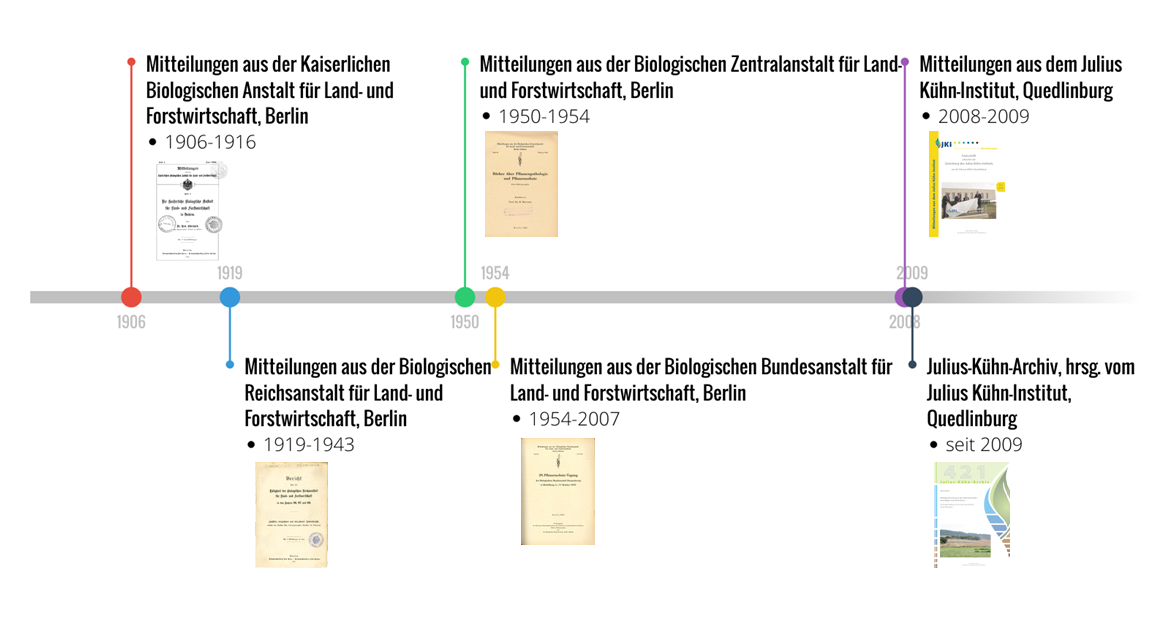About the Journal
Focus and Scope
In the book series Julius-Kühn-Archiv conference proceedings are published at irregular intervals. Since December 2021, the issues have been published online only. The individual contributions have the character of scientific articles and are evaluated before publication by a conference committee or by external reviewers. The papers are presented at conferences hosted by the Julius Kühn Institute (JKI).
Peer Review
The contributions in the Julius-Kühn-Archiv are reviewed at least editorially. In the case of conference proceedings, the contributions are reviewed by external reviewers or by the conference organisers.
Open Access Policy
This journal provides open access to its content, in the belief that the free public availability of research results promotes the global exchange of knowledge. Since issue 459, all content of the Julius Kühn Archive has been published under a Creative Commons Attribution 4.0 licence. Publication is free of charge for editors and authors of conference proceedings. Authors may publish all versions of their contributions in print or on websites of their choice, as long as the original source is cited.
Accessibility
The JKI is committed to making all its series of publications as accessible as possible. Thus, authors of the Julius-Kühn-Archiv are requested to use the document template and to perform an accessibility check for the final manuscript. In order to ensure accessibility, authors are requested to observe the following instructions:
Mandatory:
- Use the document template for the Julius-Kühn-Archive, which you can request from the managing editor. In it, all headings are created using the Word styles. Please do not change the names of these styles.
- Do not use superfluous line breaks (<enter>). Spacing to paragraphs is specified in the template’s styles.
- Insert all elements "With text in line".
- Add alternative texts to all figures and tables. These contain at least the figure subheading or table heading; preferably, however, a brief description of the content presented and the quintessence or main message of the figure or table. Instructions on how to insert the alternative texts in Word can be found in the document template.
- Set the correct language for all text passages.
- Please do not use the labels Word automatically creates for numbering figures and tables. This will cause problems when converting to PDF
Desired:
- If possible, tables should not contain connected fields and coloured or patterned cells.
- Align all tables, formulas, figures, and graphics without indentation to the left.
- Copy formulas into a frameless text box each time so they can have alternate text.
- Do not use additional shapes in graphics or images.
- Do not use justification, hyphenation, symbols, or colour highlighting.
- Do not use Roman numerals in numbering and always use Word's numbering library.
- Headers and footers should be left blank, as they are ignored by screen readers.
- Footnotes should be avoided. Explanations should be given in the text itself instead.
Figures/Images
Figures or images should be inserted with a minimum width of 10 cm (approx. 1,000 px) and with a minimum resolution of 300 dpi. Coloured illustrations are possible.
Graphics can - if possible - also be inserted in a vector-based file format to ensure scaling without loss of quality.
Bibliography
Cite only relevant and already published sources. If you want to cite unpublished sources or data, please deposit them in an open access repository beforehand in order to refer to them in the reference.
For the correct citation style, please refer to the Journal für Kulturpflanzen. If you work with the literature management programmes EndNote or Citavi, the citation style is available in the download area (EndNote) or directly in the programme (Citavi).
Citations should be inserted in the text by mentioning the last name of the author or authors and the year (Author et al., 2018) or (Author & Author, 2020). If there are more than two authors in a reference, the second and all subsequent authors are abbreviated to "et al.". If multiple citations are referenced at the same time, they are sorted chronologically in ascending order.
Editor information on editing, layout and publication
Before working on the manuscript, conference committees or editors of the proceedings are strongly advised to announce upcoming proceedings to the editor Dr. Anja Hühnlein (publizieren@julius-kuehn.de) at least 3 months before the desired publication date. The notice should also indicate the planned scope, the procedure regarding proofreading and the desired publication date.
The individual contributions are to be assembled in the desired order by the respective editors of the conference proceedings and sent as a Word document to Manuela Kynast (publizieren@julius-kuehn.de and manuela.kynast@julius-kuehn.de). The Word documents have to be sent at least 6 weeks before publication date.
In the editorial office, final checks are made for accessibility, structure, and formatting of the contributions. There is no check for spelling and grammar. The proofread manuscript is complemented with a cover and masthead and sent as PDF file to the editors of the proceedings for publication approval.
Afterwards, the conference proceedings will be published online at the OpenAgrar repository.
History




